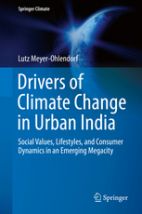Drivers of Climate Change in Urban India: Social Values, Lifestyles, and Consumer Dynamics in an Emerging Megacity

The emerging megacity of the book’s title is Hyderabad, a quickly growing city of about 9 million people in the southern Indian state of Telangana.
Drivers of Climate Change in Urban India, which developed from a PhD thesis, focuses on the climate change impacts of lifestyles in Hyderabad. Meyer-Ohlendorf surveyed 600 respondents to learn about the emissions associated with various types of consumption, such as electricity and motorized transport use. Hyderabad’s residents aren’t major users of air conditioning or flights, and while the greenhouse gas emissions of its middle class are rising rapidly, they’re still a fraction of middle-class emissions in wealthier countries.
The book is very interested in theoretical and methodological aspects, and devotes plenty of attention to the lifestyle typology developed by the author. He reviews different approaches for quantifying income and consumption. Meyer-Ohlendorf also lays out in detail Hyderabad’s historical and economic context and the effects of urbanization on India’s climate policy. This creates a picture of larger social forces behind individual carbon footprints, and of each step of the author’s methodological journey. For instance, he explains how and why he constructed “mentalities” as a unit of analysis, and how he linked survey responses to attitudes of hedonism or thrift.
Ultimately, “The results of this study show that income, apart from personal and household wealth, has the most significant impact on individual carbon footprints” (page 245). However, there isn’t a uniform correlation between higher incomes and more carbon-intensive behaviours. For instance, the research found that higher incomes were associated with less meat consumption, likely for religious reasons.
Drivers of Climate Change in Urban India appears most useful for social scientists studying climate change, or climate scientists interested in social and cultural impacts on emissions, especially those looking to apply a mixture of quantitative and qualitative research tools in specific urban settings.
Further reading:
Bhushan, Chandra (2018), A Commentary on Consumption: Rich Indians versus Rich (and Poor) Americans, Centre for Science and Environment, available at https://www.cseindia.org/a-commentary-on-consumption-rich-indians-versus....
Revi, Aromar (2008), “Climate change risk: an adaptation and mitigation agenda for Indian cities”, Environment and Urbanization Vol 20, No 1, pages 207–229, available at https://journals.sagepub.com/doi/pdf/10.1177/0956247808089157.
Satterthwaite, David (2009), “The implications of population growth and urbanization for climate change”, Environment and Urbanization Vol 21, No 2, pages 545–567, available at https://journals.sagepub.com/doi/pdf/10.1177/0956247809344361.
Book note prepared by Christine Ro
Search the Book notes database
Our Book notes database contains details and summaries of all the publications included in Book notes since 1993 - with details on how to obtain/download.
Use the search form above, or visit the Book notes landing page for more options and latest content.
For a searchable database for papers in Environment and Urbanization, go to http://eau.sagepub.com/

